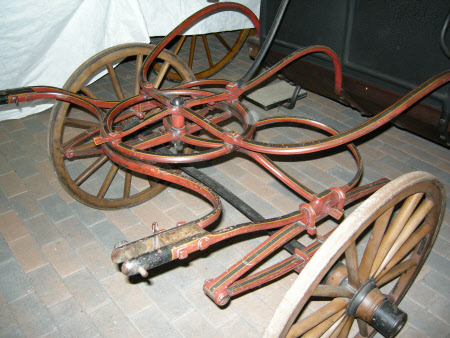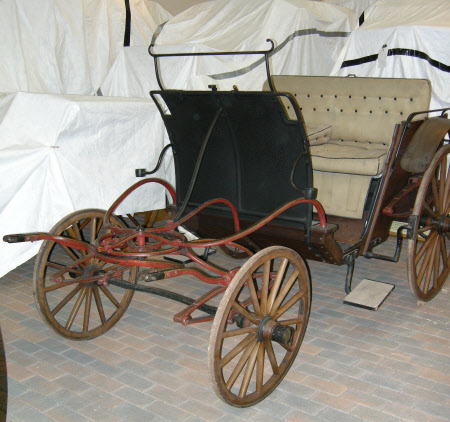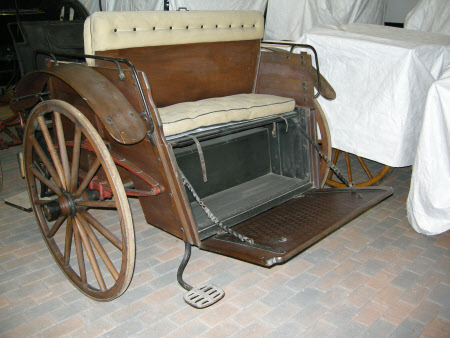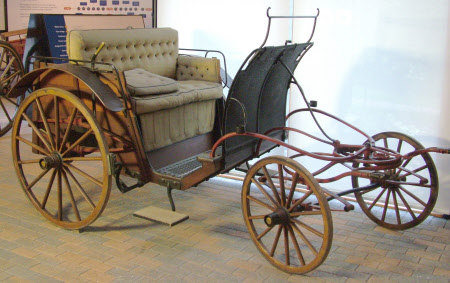Eridge cart
Rock, Thorpe and Chatfield
Category
Carriages & other vehicles
Date
1890 - 1925
Materials
Varnished wood body with leather dash board and cord upholstery, four iron shod wheels.
Measurements
150.5 x 304 x 170cm (4ft 11 1/4in x 9ft 11 2/3in x 5ft 7in)
Place of origin
England
Order this imageCollection
National Trust Carriage Museum
NT 272883.1
Caption
This unique carriage was designed for the 5th Earl of Abergavenny. (Pictured here at his home, Eridge Castle, near Tunbridge Wells in Kent). The Earl required a low carriage as he grew older for ease of access. By placing the front wheels ahead of the body, it could be lowered but still allow a tight turning circle.
Summary
Eridge Cart built by Rock, Thorpe and Chatfield of Tonbridge Wells and London circa 1890. Eridge Cart (four wheels) for a single pony. The body is sprung on elliptic springs and is in good, original condition. The carriage is finished in natural wood with black, red and gold lining with three cushions upholstered in cream cordroy.
Full description
This dog cart variant was evidently built for the Earl of Abergavenny in his old age. The floor is only approximately 400mm above the ground, so the carriage can easily be entered without a step. However, large rectangular platform steps were added to make it even easier. They do not appear in the photograph of the carriage outside the front door of Eridge Castle. In this photograph it is being drawn by a pony of approximately 14.1 hh, the same height as the rein rail. This vehicle was built for the Earl of Abergavenny, by Rock, Thorpe & Chatfield of Tunbridge Wells, Kent, in the early 20th century, and named after his nearby property Eridge Castle. This is a dogcart variant with the characteristic back-to-back seating for four passengers. The unusual style of painted ironwork combines very nicely with the varnished wheels and the body, with alternate planks of contrasting timber, as well as the tan corduroy trimming, to produce a most attractive little carriage for informal country driving with a single horse. The Earl wanted a low vehicle when he was less mobile but still able to drive himself. To lower the body the front wheels are placed ahead of it, instead of underneath it in the usual way, giving the carriage its distinctive look.
Marks and inscriptions
On front nearside axle component.: ROCK THORPE & CHATFIELD TUNBRIDGE WELLS & LONDON On front offside axle component.: ROCK THORPE & CHATFIELD TUNBRIDGE WELLS & LONDON On rear nearside axle component.: ROCK THORPE & CHATFIELD TUNBRIDGE WELLS & LONDON On rear offside axle component.: ROCK THORPE & CHATFIELD TUNBRIDGE WELLS & LONDON Stamped on the back rail.: 5242 Stamped on inside of tailboard.: 5242 Stamped on back edge of grooms seat.: 5242 On nearside front axle components.: GRISE & HARRISON BIRM'M*909 On offside front axle components.: GRISE & HARRISON BIRM'M*909 On nearside rear axle components.: GRISE & HARRISON BIRM'M*909 On rear offside axle components.: GRISE & HARRISON BIRM'M*909 On front nearside axle components.: R5242 On front offside axle components.: R5242 On rear nearside axle components.: R5242 On rear offside axle components.: E5242
Makers and roles
Rock, Thorpe and Chatfield, coach builder





